Nitin Agarwal
MANGO: Multimodal Attention-based Normalizing Flow Approach to Fusion Learning
Aug 13, 2025Abstract:Multimodal learning has gained much success in recent years. However, current multimodal fusion methods adopt the attention mechanism of Transformers to implicitly learn the underlying correlation of multimodal features. As a result, the multimodal model cannot capture the essential features of each modality, making it difficult to comprehend complex structures and correlations of multimodal inputs. This paper introduces a novel Multimodal Attention-based Normalizing Flow (MANGO) approach\footnote{The source code of this work will be publicly available.} to developing explicit, interpretable, and tractable multimodal fusion learning. In particular, we propose a new Invertible Cross-Attention (ICA) layer to develop the Normalizing Flow-based Model for multimodal data. To efficiently capture the complex, underlying correlations in multimodal data in our proposed invertible cross-attention layer, we propose three new cross-attention mechanisms: Modality-to-Modality Cross-Attention (MMCA), Inter-Modality Cross-Attention (IMCA), and Learnable Inter-Modality Cross-Attention (LICA). Finally, we introduce a new Multimodal Attention-based Normalizing Flow to enable the scalability of our proposed method to high-dimensional multimodal data. Our experimental results on three different multimodal learning tasks, i.e., semantic segmentation, image-to-image translation, and movie genre classification, have illustrated the state-of-the-art (SoTA) performance of the proposed approach.
PRISM: Perceptual Recognition for Identifying Standout Moments in Human-Centric Keyframe Extraction
Jun 23, 2025Abstract:Online videos play a central role in shaping political discourse and amplifying cyber social threats such as misinformation, propaganda, and radicalization. Detecting the most impactful or "standout" moments in video content is crucial for content moderation, summarization, and forensic analysis. In this paper, we introduce PRISM (Perceptual Recognition for Identifying Standout Moments), a lightweight and perceptually-aligned framework for keyframe extraction. PRISM operates in the CIELAB color space and uses perceptual color difference metrics to identify frames that align with human visual sensitivity. Unlike deep learning-based approaches, PRISM is interpretable, training-free, and computationally efficient, making it well suited for real-time and resource-constrained environments. We evaluate PRISM on four benchmark datasets: BBC, TVSum, SumMe, and ClipShots, and demonstrate that it achieves strong accuracy and fidelity while maintaining high compression ratios. These results highlight PRISM's effectiveness in both structured and unstructured video content, and its potential as a scalable tool for analyzing and moderating harmful or politically sensitive media in online platforms.
Improving search relevance of Azure Cognitive Search by Bayesian optimization
Dec 13, 2023



Abstract:Azure Cognitive Search (ACS) has emerged as a major contender in "Search as a Service" cloud products in recent years. However, one of the major challenges for ACS users is to improve the relevance of the search results for their specific usecases. In this paper, we propose a novel method to find the optimal ACS configuration that maximizes search relevance for a specific usecase (product search, document search...) The proposed solution improves key online marketplace metrics such as click through rates (CTR) by formulating the search relevance problem as hyperparameter tuning. We have observed significant improvements in real-world search call to action (CTA) rate in multiple marketplaces by introducing optimized weights generated from the proposed approach.
Detecting Suspicious Commenter Mob Behaviors on YouTube Using Graph2Vec
Nov 09, 2023


Abstract:YouTube, a widely popular online platform, has transformed the dynamics of con-tent consumption and interaction for users worldwide. With its extensive range of content crea-tors and viewers, YouTube serves as a hub for video sharing, entertainment, and information dissemination. However, the exponential growth of users and their active engagement on the platform has raised concerns regarding suspicious commenter behaviors, particularly in the com-ment section. This paper presents a social network analysis-based methodology for detecting suspicious commenter mob-like behaviors among YouTube channels and the similarities therein. The method aims to characterize channels based on the level of such behavior and identify com-mon patterns across them. To evaluate the effectiveness of the proposed model, we conducted an analysis of 20 YouTube channels, consisting of 7,782 videos, 294,199 commenters, and 596,982 comments. These channels were specifically selected for propagating false views about the U.S. Military. The analysis revealed significant similarities among the channels, shedding light on the prevalence of suspicious commenter behavior. By understanding these similarities, we contribute to a better understanding of the dynamics of suspicious behavior on YouTube channels, which can inform strategies for addressing and mitigating such behavior.
Image-Driven Furniture Style for Interactive 3D Scene Modeling
Oct 20, 2020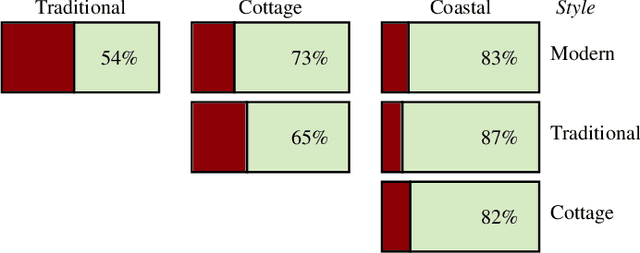
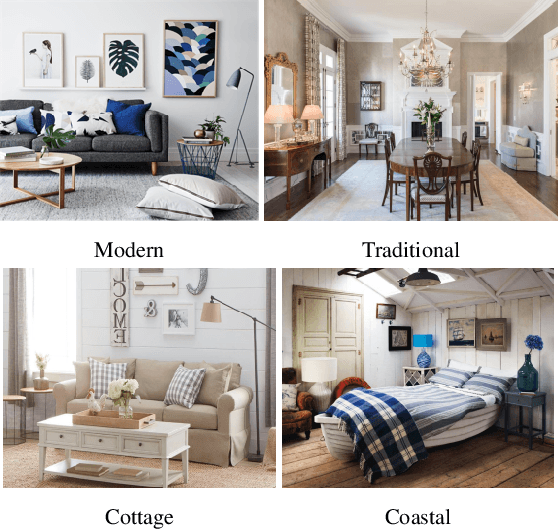
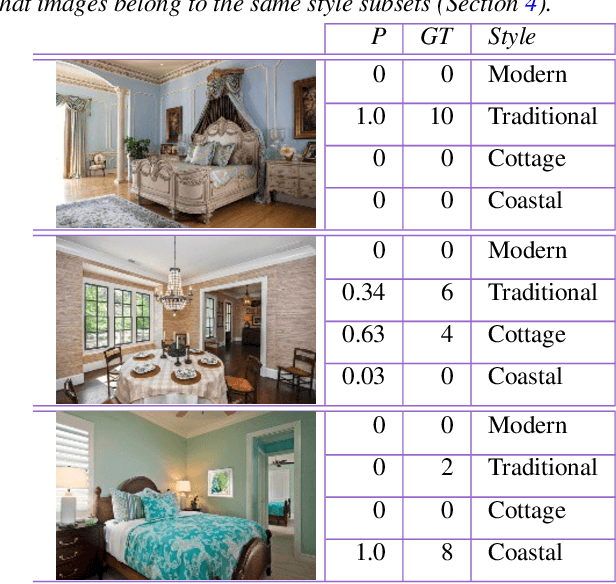
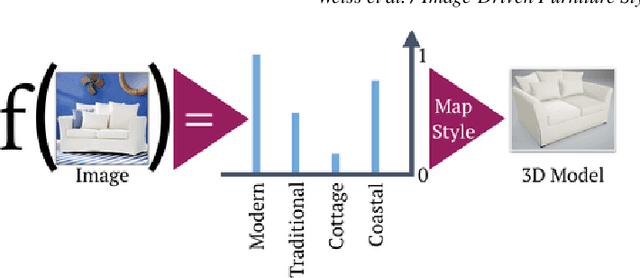
Abstract:Creating realistic styled spaces is a complex task, which involves design know-how for what furniture pieces go well together. Interior style follows abstract rules involving color, geometry and other visual elements. Following such rules, users manually select similar-style items from large repositories of 3D furniture models, a process which is both laborious and time-consuming. We propose a method for fast-tracking style-similarity tasks, by learning a furniture's style-compatibility from interior scene images. Such images contain more style information than images depicting single furniture. To understand style, we train a deep learning network on a classification task. Based on image embeddings extracted from our network, we measure stylistic compatibility of furniture. We demonstrate our method with several 3D model style-compatibility results, and with an interactive system for modeling style-consistent scenes.
GAMesh: Guided and Augmented Meshing for Deep Point Networks
Oct 19, 2020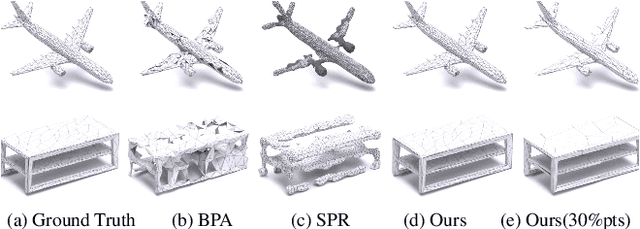
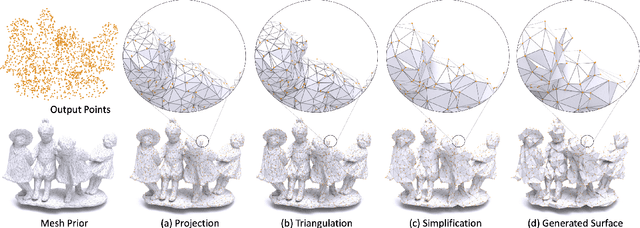
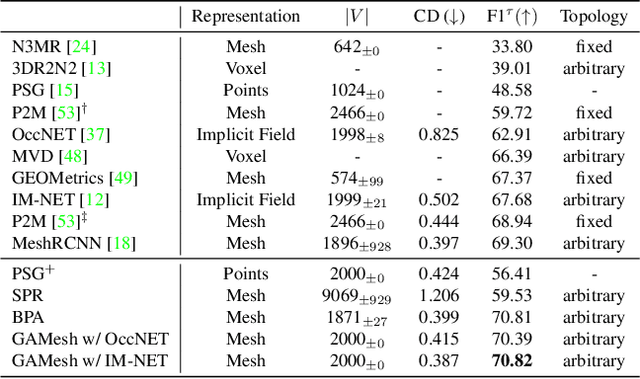
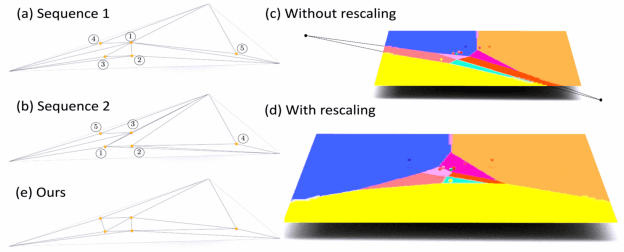
Abstract:We present a new meshing algorithm called guided and augmented meshing, GAMesh, which uses a mesh prior to generate a surface for the output points of a point network. By projecting the output points onto this prior and simplifying the resulting mesh, GAMesh ensures a surface with the same topology as the mesh prior but whose geometric fidelity is controlled by the point network. This makes GAMesh independent of both the density and distribution of the output points, a common artifact in traditional surface reconstruction algorithms. We show that such a separation of geometry from topology can have several advantages especially in single-view shape prediction, fair evaluation of point networks and reconstructing surfaces for networks which output sparse point clouds. We further show that by training point networks with GAMesh, we can directly optimize the vertex positions to generate adaptive meshes with arbitrary topologies.
Learning Embedding of 3D models with Quadric Loss
Jul 24, 2019
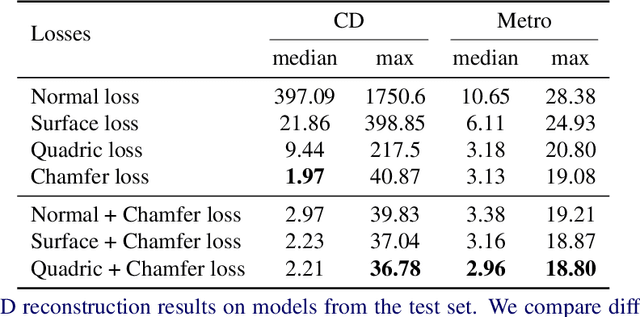
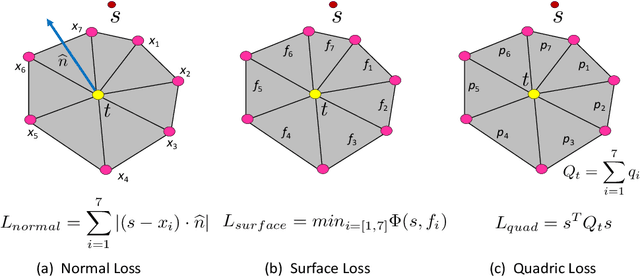
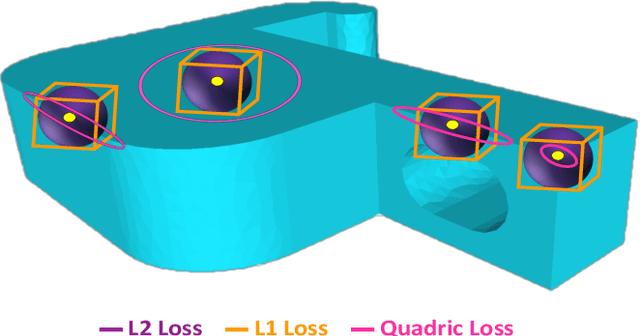
Abstract:Sharp features such as edges and corners play an important role in the perception of 3D models. In order to capture them better, we propose quadric loss, a point-surface loss function, which minimizes the quadric error between the reconstructed points and the input surface. Computation of Quadric loss is easy, efficient since the quadric matrices can be computed apriori, and is fully differentiable, making quadric loss suitable for training point and mesh based architectures. Through extensive experiments we show the merits and demerits of quadric loss. When combined with Chamfer loss, quadric loss achieves better reconstruction results as compared to any one of them or other point-surface loss functions.
Linked Causal Variational Autoencoder for Inferring Paired Spillover Effects
Oct 03, 2018
Abstract:Modeling spillover effects from observational data is an important problem in economics, business, and other fields of research. % It helps us infer the causality between two seemingly unrelated set of events. For example, if consumer spending in the United States declines, it has spillover effects on economies that depend on the U.S. as their largest export market. In this paper, we aim to infer the causation that results in spillover effects between pairs of entities (or units), we call this effect as \textit{paired spillover}. To achieve this, we leverage the recent developments in variational inference and deep learning techniques to propose a generative model called Linked Causal Variational Autoencoder (LCVA). Similar to variational autoencoders (VAE), LCVA incorporates an encoder neural network to learn the latent attributes and a decoder network to reconstruct the inputs. However, unlike VAE, LCVA treats the \textit{latent attributes as confounders that are assumed to affect both the treatment and the outcome of units}. Specifically, given a pair of units $u$ and $\bar{u}$, their individual treatment and outcomes, the encoder network of LCVA samples the confounders by conditioning on the observed covariates of $u$, the treatments of both $u$ and $\bar{u}$ and the outcome of $u$. Once inferred, the latent attributes (or confounders) of $u$ captures the spillover effect of $\bar{u}$ on $u$. Using a network of users from job training dataset (LaLonde (1986)) and co-purchase dataset from Amazon e-commerce domain, we show that LCVA is significantly more robust than existing methods in capturing spillover effects.
Geometry Processing of Conventionally Produced Mouse Brain Slice Images
Dec 27, 2017



Abstract:Brain mapping research in most neuroanatomical laboratories relies on conventional processing techniques, which often introduce histological artifacts such as tissue tears and tissue loss. In this paper we present techniques and algorithms for automatic registration and 3D reconstruction of conventionally produced mouse brain slices in a standardized atlas space. This is achieved first by constructing a virtual 3D mouse brain model from annotated slices of Allen Reference Atlas (ARA). Virtual re-slicing of the reconstructed model generates ARA-based slice images corresponding to the microscopic images of histological brain sections. These image pairs are aligned using a geometric approach through contour images. Histological artifacts in the microscopic images are detected and removed using Constrained Delaunay Triangulation before performing global alignment. Finally, non-linear registration is performed by solving Laplace's equation with Dirichlet boundary conditions. Our methods provide significant improvements over previously reported registration techniques for the tested slices in 3D space, especially on slices with significant histological artifacts. Further, as an application we count the number of neurons in various anatomical regions using a dataset of 51 microscopic slices from a single mouse brain. This work represents a significant contribution to this subfield of neuroscience as it provides tools to neuroanatomist for analyzing and processing histological data.
 Add to Chrome
Add to Chrome Add to Firefox
Add to Firefox Add to Edge
Add to Edge